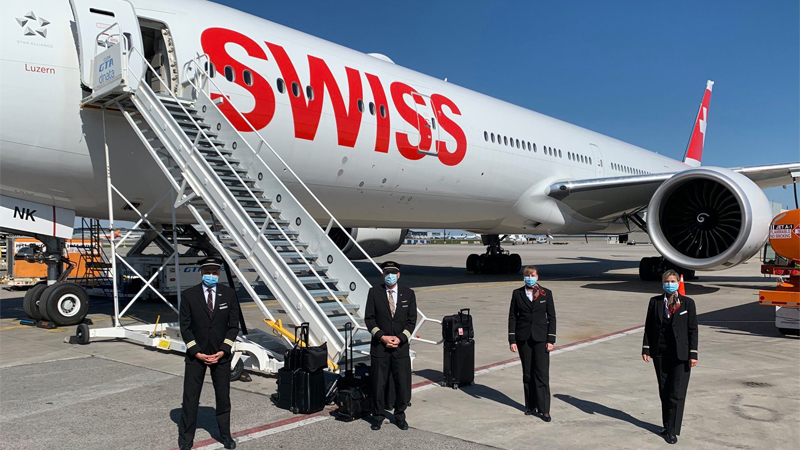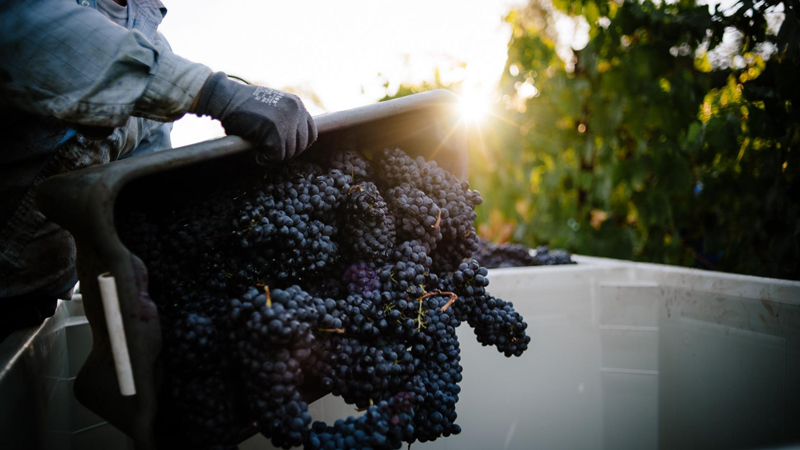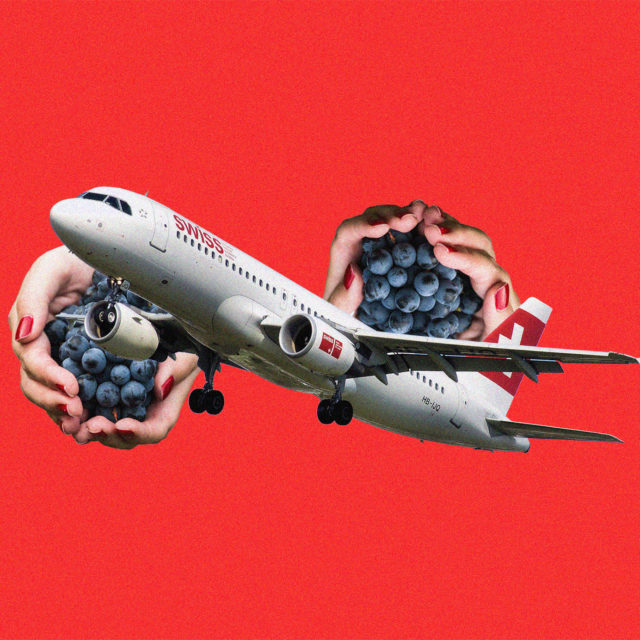It’s not unusual for Swiss wineries to bring in vineyard workers from other European countries to help with the annual harvest. Each year, laborers arrive from Portugal, Spain, France, and Poland by car, bus, train, and plane. This year, for the first time, Portuguese workers were airlifted into the country on a chartered Swiss International Air Lines A220-300 Airbus.
Arranged on behalf of the Swiss agriculture association AgriGenève, the early May flight carried 141 guest workers from Porto to Geneva to provide assistance in the lead-up to the 2020 harvest. More flights are planned for June, July, and October. “This year, due to Covid-19, it was very difficult to come to Switzerland by road because Spain closed its borders,” says François Erard, director of AgriGenève. Thus, we contacted Swiss Air to study the possibility of bringing our Portuguese employees by plane.”
Swiss wineries aren’t the only ones facing logistical challenges for the 2020 harvest — from securing the necessary laborers to keeping workers healthy in the vineyards. Throughout the Northern Hemisphere, in countries such as France, Spain, Italy, and the United States, vintners are developing new strategies and searching for creative solutions in a year like no other.
Changes in Champagne
When France’s pandemic lockdown happened in mid-March, Champagne growers and producers had to make immediate changes in the vineyards to keep production going.
“Social distancing in the vineyard is simple if you put your workers several rows apart from each other as opposed to one row away,” says Thibaut Le Mailloux, director of communications for the Champagne trade association Comité Interprofessionnel du Vin de Champagne (CIVC) in Épernay. “With a recommended social distance in France of one meter, CIVC asked growers to space vineyard workers four to five rows apart.”
Trellising will present the region’s next dilemma. More than 50,000 laborers perform the task each June, and while most of this workforce is local, the sheer number of people working in the vineyards will make distancing difficult — especially since the average domaine size in Champagne is less than two hectares. “Rather than having several people working successively in all plots, which was the practice before,” says Le Mailloux, “the practice this year is to have one worker in each plot.”
During harvest, even more laborers will be needed. Because all picking in Champagne must be done by hand, it takes 120,000 seasonal workers to get the job done. Nearly 60 percent of those laborers typically come from Eastern Europe.
“We are working with the government to figure out how we will be able to hire this foreign workforce,” Le Mailloux says, “but it all depends on the opening of the borders by the EU.”

If that doesn’t happen in time for harvest, CIVC may turn to a local workforce: French citizens who’ve lost their jobs due to the pandemic. Last year, Champagne representatives negotiated a fortuitous measure with the French government that allows unemployed people to earn money working the harvest without losing their social welfare benefits. The government also helped create digital job search platforms to connect farmers with potential workers.
But even so, Le Mailloux says, it’s not an easy fix. People who are not accustomed to working in agriculture often abandon harvest labor after a short period, and those coming to Champagne from other areas of the country would need socially distanced housing.
“Traditionally the Champagne houses and growers hosted seasonal workers in their own facilities, but due to the number of square meters and number of showers available for every 10 people, that’s not possible anymore,” Le Mailloux says. “Getting more flexibility for housing would increase our capacity to recruit and would be motivating for people to come and harvest in Champagne.”
Similar Approach, Different Countries
Freixenet Mionetto, which owns vineyard estates in Italy’s Veneto and Tuscany regions, along with Spanish estates in Catalunya and Penedés, and Gloria Ferrer in California, is busy implementing increased safety and sanitation measures at its properties.
“It’s a similar approach in different countries, but with different solutions,” says Enore Ceola, CEO and president at Freixenet Mionetto USA. “Of course, everyone is wearing PPE [personal protective equipment] and we make sure that everybody is very far from each other — a lot more than six feet.”
Vineyard and crush crews will also spend more time cleaning their equipment and grape-picking boxes. “We were sanitizing these things even before the virus,” Ceola says, “but this year we’ll be even more careful about that.”
Since most of the company’s harvest crews in Spain and Italy are local workers, and some of the picking in Spain is done by machines, he adds, labor and housing shouldn’t be an issue in those countries.
However, the situation for small, independent producers is likely to be more difficult. For some, the question isn’t how to safely harvest or how to get enough workers, it’s whether to harvest at all.
“We have wine in stock that we didn’t sell because orders were canceled right at the outbreak of Covid-19,” says Reka Haros, co-owner of Sfriso Winery in Italy’s Veneto region. “We do not have news as of when the internal regional and external country borders will reopen, so we cannot count on selling direct to consumer at the cellar door.”
And if she can’t sell the wines already in the cellar, she says, there would be little point in making more. “We are considering not bottling any of this year’s production,” says Haros. “Any prediction is useless at the moment, but until we sell this high stock, we won’t consider adding to it with a 2020 vintage.”
California’s Challenges
While harvest logistics aren’t a significant headache for Freixenet Mionetto in Italy and Spain, the situation may prove more taxing in California, where wineries often rely on guest workers from Mexico. With the border between the United States and Mexico closed due to the pandemic, Ceola says he’s concerned about losing that crucial workforce. “This year it’s probably going to be challenging,” he says. “We don’t know yet what will happen.”
Jeff Bitter, president of Allied Grape Growers, a grower-owned wine-grape marketing association based in Fresno, says he doesn’t expect California’s harvest labor pool to be any smaller this year due to Covid-19.

“If we’re tightening things up at the Mexican border in the interest of public safety,” Bitter says, “that could definitely have a negative impact on the availability of the workforce. But with the amount of people out of work in the hospitality and entertainment sectors, I think there’s actually a possibility that there will be additional workers for agriculture.”
To keep laborers healthy in the vineyards, growers are implementing physical distancing practices and stepping up sanitation. “PPE is already a normal part of life on a vineyard or any type of farming operation,” Bitter says. “Growers are going to have to implement the same type of measures that employers everywhere will be using — having plenty of hand sanitizer around and an increased sanitation schedule for surfaces that people touch frequently.”
All this extra effort will cost growers both time and money, notes John Aguirre, president of the California Association of Winegrape Growers in Sacramento. “Labor costs keep going up, and now, more time is needed to train workers to maintain physical distancing during breaks and obviously during work,” he says. “And you’ve got to look for signs if any of your workers are showing symptoms of Covid-19. There’s just a lot for the grower to manage in this environment.”
Harvest Intern Headaches
At Lambert Bridge Vineyards in Sonoma County, harvest interns are an important part of the winery’s seasonal labor crew. With international travel nearly at a halt, these workers have suddenly become scarce.
Each year between Aug. 1 and the end of October, the winery brings in four seasonal employees for the harvest — typically from South America, South Africa, Italy, or France. Due to uncertainties about travel restrictions for visitors from countries hard hit by the pandemic, one of Lambert Bridge’s South American interns has already dropped out.
“It’s a challenge to find interns right now,” says vice president and general manager Bill Smart. “We’re interviewing like mad.”
Nevertheless, Smart is already preparing for the interns’ arrival. “We rented a house in Healdsburg where they can safely stay and socially distance,” he says, “and we planned a 14-day quarantine for any of our incoming interns. We’ve also made it clear to them that this harvest is not going to be normal — there will be lots of changes to ensure everyone’s safety.”
Harvest workers must be masked and gloved, and will work in staggered shifts to ensure physical distancing as much as possible. When they’re not working, all of the winery’s harvest staff members will self-quarantine. Making frequent use of sanitation stations will be mandatory, as will consistent bathroom wipe-downs.
Keeping the harvest crew safe is Smart’s top priority this year — not only because he cares about the health of his employees, but because it’s essential for Lambert Bridge’s business. “We are terrified of the thought of having to shut down for 14 days during harvest if someone on our team gets Covid-19,” he says. “Grapes don’t wait to ripen because they are concerned about a pandemic.”
This story is a part of VP Pro, our free platform and newsletter for drinks industry professionals, covering wine, beer, liquor, and beyond. Sign up for VP Pro now!
